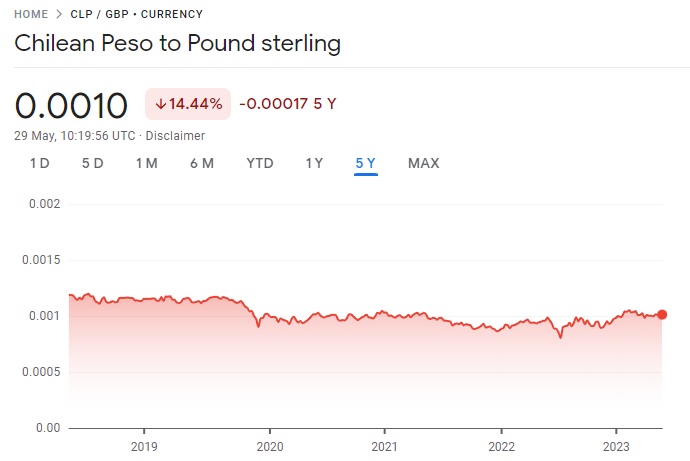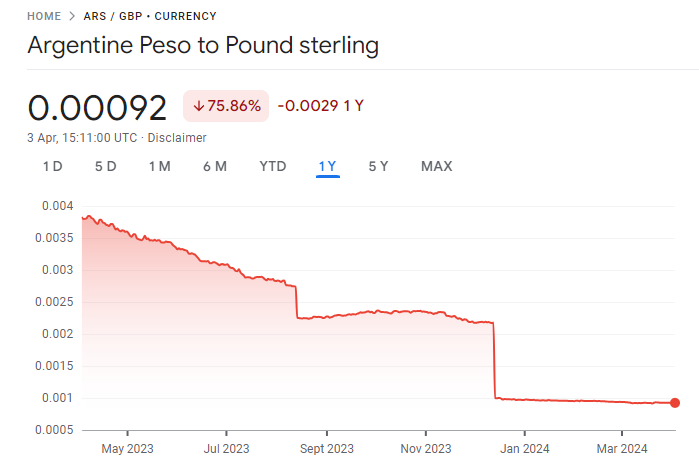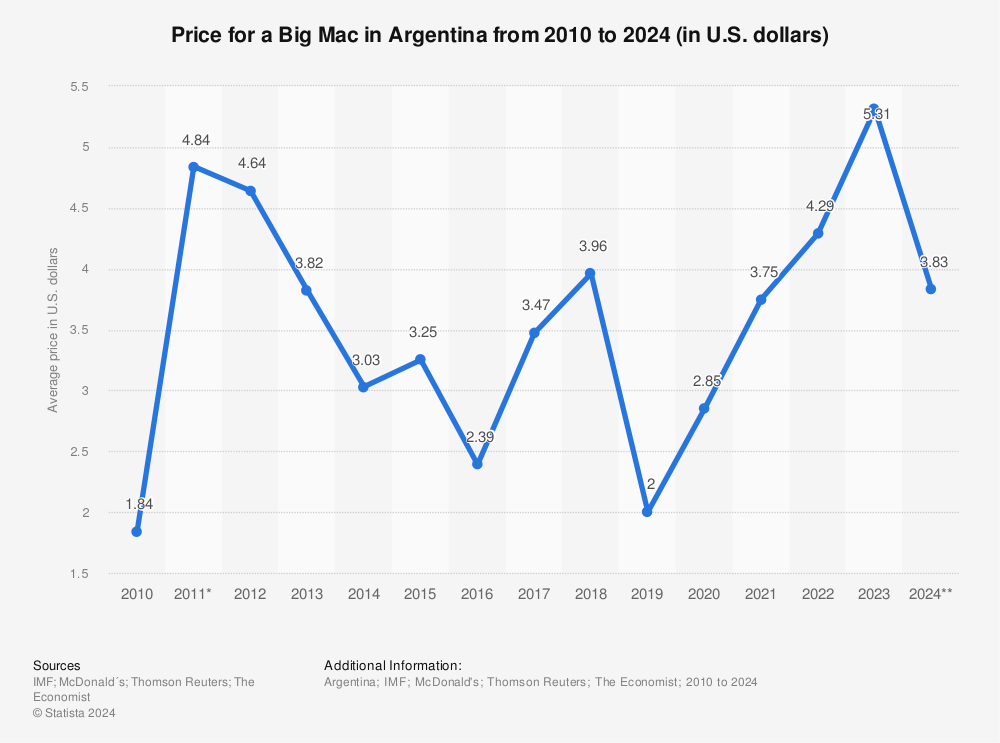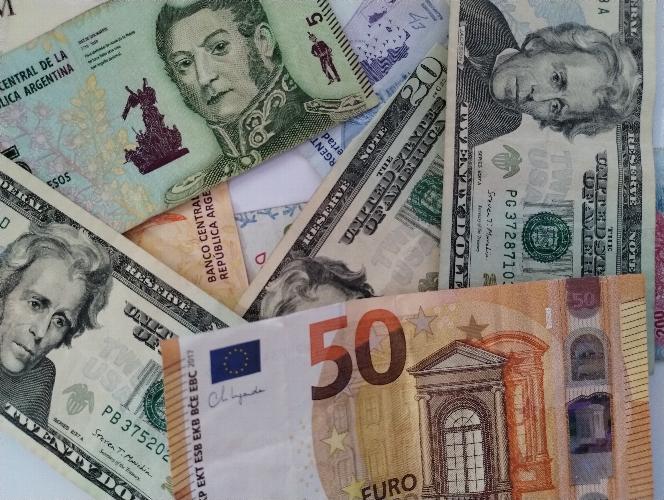Money matters - Chile vs Argentina
Argentina update April 2024
The economy of these two countries couldn't be more different. On the one hand, we have stable Chile, with a Peso that, even if it has a relatively low value (e.g. about 10000 to the Pound), has remained relatively unchanged for at least the last five years, as you can see from the graph below:

But the same can't be said about the Argentine Peso, as seen from the graph below.

Following the recent presidential election at the end of 2023, when the extreme neoliberal capitalist Javier Milei was elected with a large popular mandate, the currency exchange has somewhat stabilised. Inflation remains very high but with a downward trend month by month. Nevertheless, as of the date of this blog, it was running at around 13.7% per month. The graph below shows the price of a BigMac in US dollars over the last 14 years and you can easily see how erratic this trend has been (one $ will currently be the equivalent of just under 800 pesos)

Find more statistics at Statista
The cost of living in Chile and Argentina differs, with the former being still 20% more expensive but the gap is bridging. This means you would need 20% more pesos to buy the same goods and services in Chile as in Argentina.
Inflation has hit particularly badly prime necessities like food in Argentina so you will find that it is less convenient than it used to be before but still cheaper than in Western Europe. Naturally, given the size of the countries and the economic differences between metropolitan areas and the countryside, the cost of living can vary depending on the city or region you are visiting. For example, the cost of living in Santiago, Chile, is higher than in Iquique, Chile. Similarly, the cost of living in Buenos Aires, Argentina, is higher than in Rosario, Argentina.
Budgeting your trip carefully is therefore essential.
Which currency would I need to take?
Resist the temptation to look for local currency before you leave. Dollars (and Euros) are widely exchanged and welcomed (especially in Argentina). In Chile, you know from the information above that you will be dealing with a steady exchange rate for your cash, though the cost of living is higher. Things are more volatile in Argentina, but dollars and euros will be a safe bet, too.
Changing money
You can easily change dollars and euros at hotels and Casas de Cambio. Just look carefully at the daily exchange rate, bearing any commissions in mind. In Chile - depending on the fees offered by your home bank - you can also easily access cash dispensing machines in case you need to, but in general terms, you will find that with the local fees and those of your bank, it is preferable to exchange cash, rather than getting it from the dispensers.
Changing currency in Argentina is trickier as there are still several exchange rates. However, the government is fighting hard to control the black market, so the situation is very confusing. You may still find better rates on the black market, but not for long, and while the difference a year ago was as much as 50%, it could be as little as 15-20% these days. Avoid - unless in an emergency - cash machines (high local fees coupled with poor exchange rates) and banks where you will need to queue for hours, provide all your papers, and get a low rate anyway.
Remember that in Argentina, you may wake up one morning to find that the exchange rates have changed considerably (generally in your favour), so you may get more than the day before. Avoid changing too much money at once for that reason and because of the limited highest denomination in circulation. The highest banknote in circulation in Argentina now is the 2000 pesos (until May 2023, it was only 1000), worth over $2 at the time of writing. You can imagine that if you change even as little as $100, you will end up with around 40 banknotes or even more as only smaller denominations may be available so with a considerable wadge of paper to line your pockets! By the time you spend it and get more change (no coins), your bags will be bulging with banknotes, mostly of very little value, but it could all become tremendously confusing. Warning, Argentina is on course for full dollarisation, so by the time you read this blog the local currency may have disappeared with US dollars taking its place.
Credit cards
They are widely accepted in Chile and Argentina. In the latter, in 2023, the government even created a scheme (aimed at discouraging tourists from using unofficial money changers) that would refund part of the difference between the official and black market rates. We are not aware if this scheme is still in operation, but our correspondents tell us that using credit cards, given the narrowing gap between official and black market rates, remains the best-paying option.
Contactless cards are accepted, but you may also be required to enter your PIN in most cases. Paying by mobile phone is acceptable in tourist areas where shops are familiar with the process, but not elsewhere where you are still expected to exhibit your piece of plastic.
Changing currency back in the UK
Do not change too much money for the reasons stated above. You do not want to get to the last day of your stay with the equivalent value of even a hundred dollars (pounds or euros) unless you plan a shopping spree in the hugely expensive duty-free shops at the airport on ponchos or leather goods, you cannot change it back on your return. If you travel from Chile to Argentina, it is easy to exchange Chilean pesos in Argentina (but mainly only in Casas de Cambio, hotels and banks. The local dealers are not interested!) If you end up with Argentine Pesos, we advise you to spend as much as possible, leaving perhaps the equivalent of 10-20 dollars for airport expenses such as coffee. Any other small change can be given as tips, charity to the many beggars, or taken back as a (worthless) souvenir since no UK bank will change your pesos to convert into pounds or dollars (and you will need a shedload to make it worthwhile anyway). So beware!
In conclusion
Chile, Argentina (and Uruguay) are economically very different. Across the area, dollars (and Euros) are a safe bet. Change money to local currencies regularly and in moderation, avoiding ending up with unspent local cash. Wherever possible, use your debit/credit cards.

